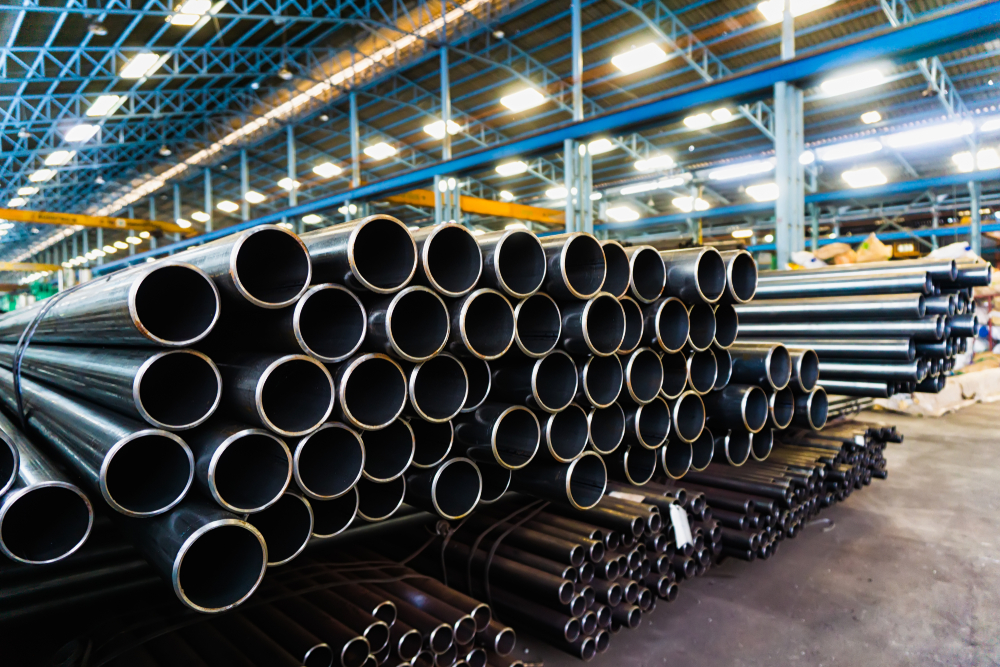Steel Pipe Basics: Uses & Dimensions Explained
December 14, 2021 | Categorized in: Types

Steel pipes can be confusing for those not familiar with the terms and different ways of referring to a pipe’s size. There are different acronyms that seem like they might be interchangeable but actually aren’t. Some of them are interchangeable, but only for certain sizes. This is why we want to break this down for anyone looking to purchase or simply understand piping.
What is a steel pipe?
Before we can explain how pipes are measured and categorized, it’s important to understand what makes a pipe a pipe (vs. a tube). A steel pipe is a cylindrical piece of steel with a hollow inside that’s generally used to carry gas or liquid from one location to another. They’re also the most utilized item produced by the steel industry.
Where are they used?
Their most obvious application is typically underground transport of fuels such as oil or natural gas, but also for water. However, pipes are also used for sewage and in construction to protect electrical wires. Steel’s strength-to-weight ratio makes steel pipes a popular choice for many bike frames, flagpoles, and street lamps as well.

Steel pipe measurements
Before we can read a pipe sizing chart, we need to understand what different measurements or dimensions are being listed.
- Length: This is fairly self-explanatory — it designates how long a piece of piping is, usually in standard increments.
- Inside diameter (ID): The inside diameter is the distance between the inside walls. It can be thought of as how wide the opening in the pipe is.
- Outside diameter (OD): The outside diameter is the distance from the outside edge to its opposite outside edge. This can be thought of as the total “height” of the pipe.
- Wall thickness (WT): Similar to length, this is relatively self-explanatory and is the thickness of the piping’s wall. It is also half of the difference between OD and ID. Wall thickness is usually referred to as “schedule” which is a non-dimensional number that needs to be converted to the actual wall thickness using a chart.
- Nominal pipe size (NPS): This is the metric that is most often used to convey the “size” of a pipe. However, the NPS is neither the ID nor the OD when it’s between ⅛” and 12”. This means that, while close to the actual diameter of the pipe, it’s another non-dimensional number and more of a designation rather than a measurement. Above 14” (or NPS 14), the nominal pipe size and OD are the same.
Nominal pipe size & outside diameter size chart
For example, below is a table of NPS values from ½” to 3 ½” with their corresponding outside diameter:
|
Nominal Pipe Size (NPS) |
Outside Diameter (OD) |
|
½” |
0.84” |
|
¾” |
1.05” |
|
1” |
1.315” |
|
1 ¼” |
1.66” |
|
1 ½” |
1.9” |
|
2” |
2.375” |
|
2 ½” |
2.875” |
|
3” |
3.5” |
|
3 ½” |
4” |
How to read steel pipe sizes
The most common format of pipe sizing is written like: 1” SCH 40 x 20’. The first part is the nominal pipe size, which means that the outside diameter is actually 1.315”. After the NPS we have the wall thickness, or schedule. SCH 40 for a 1” pipe means the wall thickness is 0.133”. Lastly, we have the length of the pipe, which is 20 feet.
Put together, 1” SCH 40 x 20’ translates to 1.315” OD, 0.133” WT, and 20’ length. While not specified in the measurement, you can also find the inside diameter using the OD and WT. A pipe with an OD of 1.315” and WT of 0.133” will have an ID of 1.049” (ID = OD – 2WT).
Get the right pipes for your project today
No matter what size or quantity of steel piping you need, Service Steel can supply it. Even better, our experts can help you decide what the best choice is for your project so you don’t need to feel pressured to be an expert in steel pipe terminology and standard sizing. Request a quote today.
